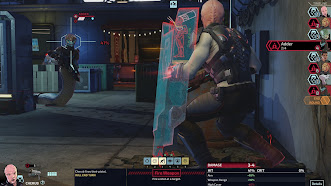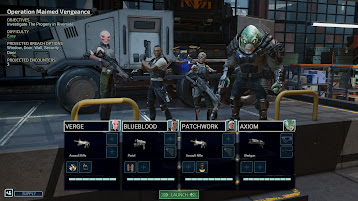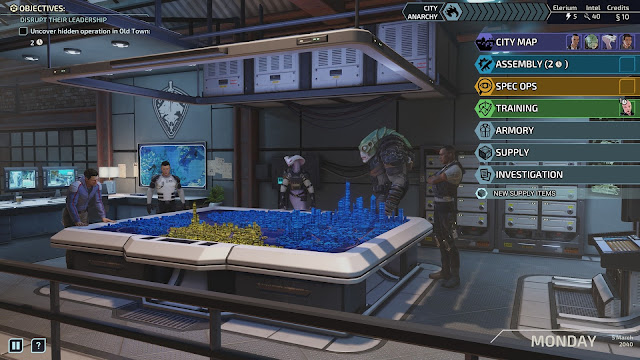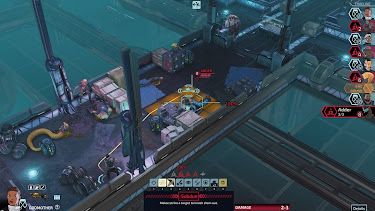Chimera Squad, a game by Firaxis, is a turn based tactics game that takes place after the events of XCOM 2.
After the liberation of Earth, XCOM has become a more influential actor on the
global stage. The remnants of the Advents forces have begun to reintegrate
into the new "normal" and as an experiment towards this end, City 31
stands at the forefront at human/alien societal integration. This facilitates
the formation of Chimera Squad, a special policing adjacent initiative designed
to show off and display the benefits of inter-species cooperation.
The first assignment, if playing the tutorial, is to rescue the city's mayor, the first elected "non-human" placed into a position of power, from a radical human extremist group.
The tutorial mission showcases the new additions that are
introduced in the game and gives the player an idea of the world and
characters they will be playing in. After this, the gameplay is open and only restricted by the tech and characters that are brought to missions.
The changes from the XCOM series norms sees each mission start by breaching an entrance before starting any operation and operatives enter a "Breach Phase" where each one can pop off a special ability, perform an attack or get to cover. This breaching mechanic is a deeper system than what it appears as a player needs to consider breaching turn orders and managing of special breaching equipment and abilities over the course of an operation.
In
addition, one needs to also consider what enemies require focusing down as a breach will potentially surpise some foes but others will be ready for it and will target agents if they are not dealt with once the breach phase is complete. One needs to further account from where a breach will potentially leave an operative once combat commences as it can potential leave them stranded, alternatively it could provide a vantage point from which they could provide support.
This implementation has a more fluent flow as missions can take place in up to three different encounters per operation (with boss takedown missions being the exception) with each encounter instigating a breach manoeuvre.
The combat engagement flow is streamlined by having the player automatically move between encounters that take place in smaller, more concentrated maps and gets one involved with the combat from the get go which replaces the larger "free flow" maps that had a more "search and destroy" level of combat engagement.
It can be a bit jarring transitioning
from the slower more planned approach of previous games but the "breach and
clear" faster paced tactical gameplay suits the theme of the story well even if the breaching cycle can feel overplayed.
Seeing as the scope is smaller, it has opted to be a more story focused experience with a fully-voiced cast of characters and in that vein it does bring some negatives as it feels "against the X-COM spirit" of rolling with the bad scenarios and overcoming it. This is because when a character reduced to zero hp they must be stabilised or it is game over.
Team members who fall or receive enough damage in combat can develop scars. These are minor negative modifiers and can stack with the only way for it to be removed with special training to overcome the weakness it introduces. It does make it decidedly less tense when it is expected by the game systems that one must get through missions without permanent loss.Another nitpick is your alien companion voices are done well enough but feel a bit too clean for period of time since liberation, probably the clearest example being Torque (a snake-like alien) and to a lesser extent Axiom ( a large muscular bipedal alien). To be clear the voice work isn't technically badly executed but does throw one off and creates a disconnect when one considers the telltale sounds these alien races made when confronting them in XCOM 2 as it comes off too "human" and can fall into tones that are bland. The others can be chalked up to their background and subsequent histories and makes enough sense to fit more consistently with what one has experienced before.
There is some fun interactions otherwise and, besides the nitpick mentioned, the
characters do a good enough job of selling the setting. The NPC dialogues in
missions and those that play, while in the Chimera Squad Command Center, between
them do a better job of selling world with the voice work as it feels better curated in service of characterising an image of the respective races that talks and allows one
to form their own generalised stereotypical image from the topics that is covered.
That said, in regards to characters there are eleven in total that form the squad plus the project director who provides off-site communications that deal with the wider view of the situation in City 31 and an on-site communication officer who takes care of operation intelligence.
One
starts initially with four and over the course of the game, after hitting story milestones, can select one additional member from a random
selection of three up to the maximum recruit limit of eight. Which always leaves three members that one will not be using per playthrough that does service in regards to playablity as characters have their own personal stories and interactions with one another.
The members of Chimera Squad are, to me personality wise - hit or miss, but thankfully if one chooses not to do the tutorial then a player can setup a squad that suits one's taste although one should not expect too much depth to the characters as it plays into that Saturday morning cartoon vibe with some serious tones sprinkled throughout.
The choice of certain team combinations can synergise very well and can take the bite out of the challenge out of combat but its characters are balanced well enough that every member is powerful enough that any combination of four can do all the content.
As there a greater focus on individual operatives, each one fills a specialised niche and follows a core type of playstyle with a few options as they level up to specialise in one of two sub-styles.
In addition when a operative reaches certain level-up milestones they can also undergo additional training that adds passive bonuses and a powerful capstone ability when they reach max level and do the associated training.
Before one can start bringing order to City 31, one needs to select from one of three factions to investigate, they are
who are human-centric group who are focused on psionics and its applications for greater personal enrichment.
are a group of disenfranchised aliens who are involved in smuggling and a push for greater independence for themselves
that consists of the remnants of the ADVENT forces who fight against the current state of affairs and wish to return it to how things were run before
Once a faction is selected, one then sets out to find leads to break up the faction's organisational ability until they find a lead to target and remove the leader from the picture. One does this by interacting with a digital representation of City 31 that is separated into 9 districts. A faction-related main mission is always displayed on the map and can be either completed immediately or it will require time to gather information to pinpoint a lead towards the faction's dealings.
At certain points after completing main objectives, the player is given a choice on which aspect of operations they wish to focus on, which brings with it its own small narrative story and this is something of a decision to choose which "dark-event" one wishes to counter with the missed option providing an associated buff to the faction in question.
Whatever the faction the player decides to investigate, it allows those that remain time to gather their strength and with that brings some replayability as each faction has their final mission play out differently based off how much time they were given to prepare.
Added to this, a few of the "dark-event"-like options will already be in effect to both provide challenge and emulate the effect of the missed opportunity from not being able to scrutise and put pressure on groups to enact their plans.
In order to help mitigate the effect these groups have on the city, Chimera Squad must be able to secure resources to be able to justify their effectiveness. The resources one collects from missions is
Elerium:
Used in late game research and equipment but is considered the least
important resource to focus on but having some in reserve is always
something to keep in mind.
Intel:
One of the most important resources as it is responsible for upgrading Field
Teams and in making purchases from the Scavenger Market. It is important
right through the game and a steady low source of it can be gathered by
capturing suspects, with a 100% chance with the capture of 5 suspects,
instead of killing them - this is made trivial by equipping all members on
an operation with tranquilizer rounds.
Credits:
Is an important resource which one uses to invest into upgrades and
purchasing researched equipment for use in operations. It is an important resource in the
early and mid-game but loses some value in the later parts when
one has settled in and developed their operatives.
From a meta-game perspective, it is usually in the player's best interest to hold off mission critical paths for as long as possible to allow one time to conduct research, complete training or provide hands-off assistance through situation completion for rewards.
Every mission type that one completes either through responding to a tactical request or a hands-off situation is considered a full day of activity and all other tasks that were available for that day are considered incomplete.
This works into the penalty system that is in place to hinder a player from "gaming" it as every tactical request mission that XCOM does not complete on the day increases a districts unrest and when it reaches max rank it then adds to a bar that indicates City 31's overall unrest tolerance represented as "Anarchy" - if Chimera Squad cannot maintain order and lets anarchy boil over - it is game over.
To aid with this, one can eventually develop stratagems to slow down and
impede the worse effects of missed missions by implementing and developing
District Field Teams. Besides increasing rewards, with increased effect
based off field team rank investment when completing missions in covered area, it also
plays a part in initiating special orders for your field teams that help with your overall investigation. These orders are:
When a player has 4 field teams deployed in districts, it can pause the District Unrest increase for 3 days or turns
After a Field Team is upgraded to rank 3, allows one to select a hands off situation type mission and mark it for completion and receive half the displayed rewards
Once there is a Field Team in every district then one can activate this
ability that reduces City 31's Anarchy rating by the lowest Field Team rank, which at max rank can reduce it by 3
One can also assign an operative to do extra side work which sidelines them for a few days but provides either additional resources or additional one time reward and eventually being able to work on reducing any of the city's unrest.
Something that is also equally important is research, which is streamlined I feel too much, but it is understandable considering the game's timeline of events. Research is more in the line of certifying technology or completing tasks that provide iterative improvements.
There is the inclusion of androids, which act as a replacement soldier that gets swapped in between breaches if a operative is downed during a mission, but is only useful if there is still a remaining breach to be done and are for all intents and purposes just another gun without any special abilities. With research, one can develop specialised parts that brings androids up to a respectable level, but does not come close to the utility a member of Chimera Squad can provide.
Probably only co-incidently, it is still a nice nod towards X-COM Apocalypse that introduced androids to the universe.
Enemy design has some elements that work against it but does a good job differentiating the factions and one can know what enemy belongs to what group by what they wear. However, the enemies variety falls somewhere on the weak side as it is mostly reskin and touched up assets from the previous games and the enemy tiers are fairly similar with the units with having different colours and pieces of armour added to the model in an attempt that indicates a focus on the enemy's specific playstyle - to its credit is visually distinct enough to get the point across but feels somewhat uninspired.
With those points in mind, Chimera Squad, at its price point, knows it is an experimental smaller title that attempts some new approaches to the established XCOM formula.
I feel it can be considered a mixed success where there are some good ideas
that does well to mix it up the formula for the better with some elements of gameplay that is competent but still having areas that do not feel right in an XCOM game.
There is clear signs to those that have played X-COM Apocalypse that there are ideas that one can see that Chimera Squad took inspiration from but doesn't follow in its footsteps at all and instead focuses on level of threat de-escalation with it only teasing something more by game's end.
The Golden Path narrative is not very deep, but has some interesting thoughts put into it at times but, I feel, the story one finds outside of that tends to be is more engaging by comparison with elements that one can spend more time appreciating.
It tries to condense what makes XCOM great into a series of bite-sized packages through its mission structure with a few moments sprinkled here and there.
Although some of the writing falls flat with some characters being a bit too much at times and the final
investigation feeling rushed as it is weakest part of the story with it wrapping up
far too quickly. It eventually points towards and settles matters with a final fight with its boss that just appears to be there for the sake of it and feeling less memorable than the build up leading to it
For better or for worse, it is a decent addition to the XCOM brand that helps solidify the narrative direction it might go into with any future release but should be judged in the light that it is a smaller side-project and with
that, it largely delivers on its price point especially if it is on sale.
Image source:
UFOpedia: Factions (Spoiler
Video Source:













Comments
Post a Comment